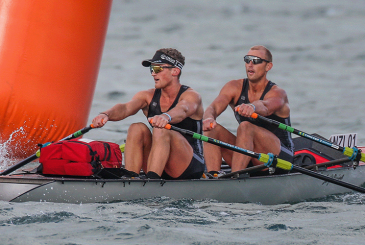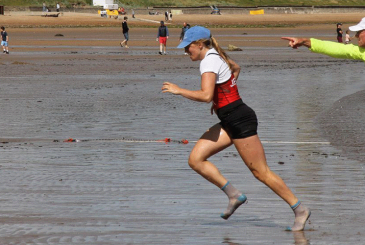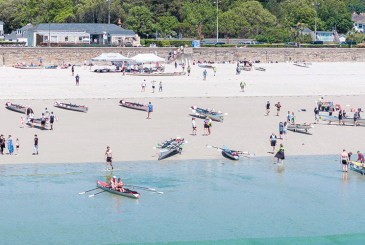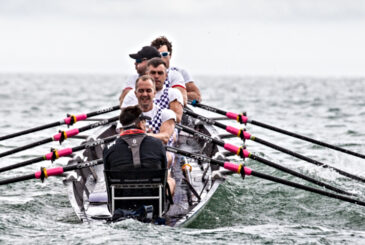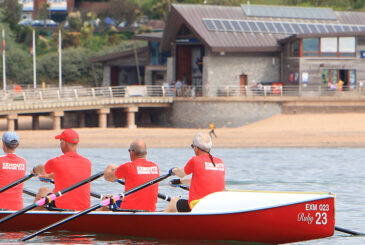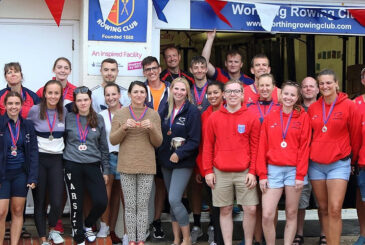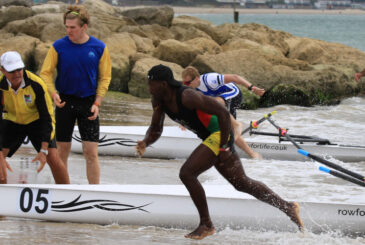Beach sprint racing is a very recent addition the domestic and international rowing calendars, and much of the wider rowing community is still only just getting to grips with the format. Amélie from Junior Rowing News finds out more from two members of the GB Rowing Team gearing up for the 2022 World Rowing Beach Sprint Finals.
As a sculler from the Midlands, the world of coastal rowing and beach sprints was not one I’ve had anything to do with and I suspect I’m not alone. That said, the discipline is rapidly gaining popularity and prestige across the globe, with athletes preparing for the upcoming World Rowing Coastal Championships and Beach Sprint Finals that are to be held in Pembrokeshire, Wales in early October. I spoke to GB’s Clare Jamison from Christchurch RC and Oliver Robertson, a junior from Newark RC, about their experiences of rowing’s wildest form of racing.
What is beach sprint racing and where did it all begin?
Competitive coastal rowing has been developing over the past four decades, with endurance racing first appearing in France in the 1980s and the first World Rowing Coastal Championships taking place in Cannes in 2007. These offshore endurance or ‘enduro’ races are run over four kilometres for heats and then six kilometres for finals, where crews generally race around several turning points.
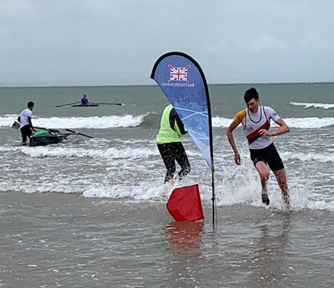
Beach sprints made their debut at the Mediterranean Beach Games of 2015, followed by the first World Rowing Beach Sprint Finals in Shenzen, China in 2019. They’re much more spectator-friendly than any other kind of rowing race as boats are never more than 250m for the beach. In a run-row-run format, a solo sculler or one member of each crew starts by sprinting on foot down the beach to their boats, which are held by boat handlers. They jump in, slalom out through a line of buoys, turn round the final one and sprint row back to the beach, where one person jumps out and dashes back up the beach to reach the finishing point on the sand.
Similarities and differences compared with other forms of rowing and racing
The main similarities between flat-water or traditional ‘inshore’ coastal rowing and coastal sculling are the structure of the stroke and therefore the muscular development required, alongside timing and co-ordination. The movement and sequencing are taught to coastal rowers in the same way; as Clare says, “They are very transferable”. This obviously counts for a lot in terms of flat-water rowers’ capacity for getting into beach sprint racing.
However, the structural similarities do not account for the difference in conditions. “New coastal rowers usually focus too much on the legs and back phases of the drive,” explained Clare. “They get very tense as a way of coping with the waves.”
It’s also worth clarifying that both enduro and beach sprint races are purely sculling events – for solos, doubles and coxed quads – so those who have only rowed sweep on flat water or at inshore coastal clubs will need to get to grips with how to scull.
Coastal racing boats are much heavier to get going
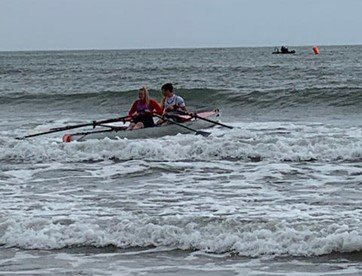
Another challenge for both flat-water and inshore coastal rowers when it comes to beach sprint racing is that the aerobic capacity required for a 500m dash with a 180 degree turn in the middle from athletes is different to that required in longer races, but this shouldn’t be off-putting to individuals wishing to try their hand at the different style of rowing. Talking to Oliver, it’s clear that the change to shorter or longer efforts requires only a small shift in the focus of aerobic training, which feels natural over the winter period.
Perhaps the biggest difference is in the preparation and equipment required for offshore coastal outings. Boats are flatter and wider to cope with the waves of the open water. Speaking with Oliver, the transition from ‘fine’ racing boats to the bulkier skeleton of coastal racing boats was a challenge. “They are much, much heavier to get going,” he told me. “It takes a lot of short sharp strokes just to move the boat”.
What if you don’t live beside the seaside?
One challenge in getting into the beach sprint format is accessing the coast to practice in big waves. However, as nowhere in Britain is further than 75 from the sea, this is manageable. In addition, beach sprint racers can do effective fitness and strength training on inland waters or indoors. Oliver admits that, “Where I live (Newark) makes it really hard to get in all the training.” Nevertheless, his success at an international level is testament to the fact that where your home is doesn’t need to be a limiting factor.
Clare and Oliver’s top tip for rowers looking to get into the new format is simply to give it a try and see where it takes you.
Want to give it a go? Find out more about beach sprints and other types of coastal rowing and where you can get involved here or contact the Beach Sprints Team Manager at [email protected] who can advise on a case by case basis.
International beach sprint’s bright future
Beach sprint rowing is already on the programme for the 2023 World Beach Games and the 2026 Youth Olympic Games in Dakar, as well as the 2026 Commonwealth Games in Victoria, Australia.
It also seems likely that coastal rowing will be included in the lineup for the 2028 Olympic Games in Los Angeles. In a 2021 interview, the President of World Rowing, Jean-Christophe Rolland, said that he is looking forward to, “Positively considering the inclusion of coastal rowing in the event programme for Los Angeles 2028.” The changes were planned for the 2024 edition in Paris, but due to the shortened cycle caused by the postponement of the Tokyo Games from 2020 to 2021, the International Olympic Committee (IOC) decided that no new disciplines were to be added in any sports in order to maintain athlete quotas and gender equity efforts.
The IOC have been planning to phase out lightweight rowing since 2017, and the inclusion of coastal rowing in the Olympics will complete this transition as a quasi-direct replacement. Beyond this, the LA edition of the Games has been deemed the perfect location to introduce coastal rowing to the programme; as Rolland put it, “The beach nature of the coastal rowing events could represent a very strong fit with the vision and venue landscape of LA”.
Photos: Oliver Robertson



